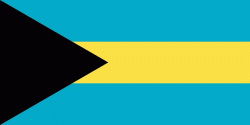Mayaguana (Mayaguana District)
Mayaguana (from Taíno language Mayaguana, meaning "Lesser Midwestern Land" ) is the easternmost island and district of The Bahamas. Its population was 277 in the 2010 census. It has an area of about 280 km2.
About 100 km north of Great Inagua and 560 km southeast of the capital Nassau, Mayaguana is considered the halfway point between South Florida and Puerto Rico and is about 830 km off Palm Beach, Florida. It is a popular stopover for boaters en-route to the eastern Caribbean.
Mayaguana was inhabited by Lucayans prior to the arrival of the Spanish following 1492. After the last of the Lucayans were carried off to Hispaniola by the Spanish early in the 16th century, the island remained uninhabited until 1812, when people began to migrate from the Turks and Caicos Islands, which are located about 100 km southeast.
The Brazilian historian Francisco Adolfo de Varnhagen suggested in 1824 that Mayaguana is Guanahani, the first island visited by Christopher Columbus at his discovery of the Americas. His theory has found little support. Mayaguana apparently was the Lucayan name (meaning "Lesser Midwestern Land" ) for the island.
The first steamship to circumnavigate the globe, the Royal Navy sloop HMS Driver, wrecked on Mayaguana on 3 August 1861, 14 years after the completion of her epic voyage in 1847.
During NASA's Project Mercury and the Apollo program, the United States space program had a missile tracking station on what is now Mayaguana Airport. The station was used to help keep astronauts on course. The Mayaguana Airport was built by US Army Engineers attached to the US Air Force. The airport was built as a runway for jet planes that would follow missiles fired from Cape Canaveral. Real-time sighting and photography was the best technology of the time for observing the flight of the missiles.
The Bahamian government has recently approved working with American investors MMC to turn Mayaguana into a "free trade zone," complete with tourism development of approximately 14% of the island. Actually, this is 14% of the total landmass but essentially most of the coastal region. The proposal was met with moderate resistance by Mayaguanians, who look forward to economic expansion but are unsure of what change is to come. This development is still in a planning phase and is trying to maintain the nature of the island as a quiet eco-tourist destination while still creating sustainable economic growth.
About 100 km north of Great Inagua and 560 km southeast of the capital Nassau, Mayaguana is considered the halfway point between South Florida and Puerto Rico and is about 830 km off Palm Beach, Florida. It is a popular stopover for boaters en-route to the eastern Caribbean.
Mayaguana was inhabited by Lucayans prior to the arrival of the Spanish following 1492. After the last of the Lucayans were carried off to Hispaniola by the Spanish early in the 16th century, the island remained uninhabited until 1812, when people began to migrate from the Turks and Caicos Islands, which are located about 100 km southeast.
The Brazilian historian Francisco Adolfo de Varnhagen suggested in 1824 that Mayaguana is Guanahani, the first island visited by Christopher Columbus at his discovery of the Americas. His theory has found little support. Mayaguana apparently was the Lucayan name (meaning "Lesser Midwestern Land" ) for the island.
The first steamship to circumnavigate the globe, the Royal Navy sloop HMS Driver, wrecked on Mayaguana on 3 August 1861, 14 years after the completion of her epic voyage in 1847.
During NASA's Project Mercury and the Apollo program, the United States space program had a missile tracking station on what is now Mayaguana Airport. The station was used to help keep astronauts on course. The Mayaguana Airport was built by US Army Engineers attached to the US Air Force. The airport was built as a runway for jet planes that would follow missiles fired from Cape Canaveral. Real-time sighting and photography was the best technology of the time for observing the flight of the missiles.
The Bahamian government has recently approved working with American investors MMC to turn Mayaguana into a "free trade zone," complete with tourism development of approximately 14% of the island. Actually, this is 14% of the total landmass but essentially most of the coastal region. The proposal was met with moderate resistance by Mayaguanians, who look forward to economic expansion but are unsure of what change is to come. This development is still in a planning phase and is trying to maintain the nature of the island as a quiet eco-tourist destination while still creating sustainable economic growth.
Map - Mayaguana (Mayaguana District)
Map
Country - The_Bahamas
 |
 |
The Bahama Islands were inhabited by the Lucayans, a branch of the Arawakan-speaking Taíno, for many centuries. Christopher Columbus was the first European to see the islands, making his first landfall in the "New World" in 1492 when he landed on the island of San Salvador. Later, the Spanish shipped the native Lucayans to and enslaved them on Hispaniola, after which the Bahama islands were mostly deserted from 1513 until 1648, nearly all native Bahamians having been forcibly removed for enslavement or having died of diseases that Europeans brought to the islands. In 1649, English colonists from Bermuda, known as the Eleutheran Adventurers, settled on the island of Eleuthera.
Currency / Language
| ISO | Currency | Symbol | Significant figures |
|---|---|---|---|
| BSD | Bahamian dollar | $ | 2 |
| ISO | Language |
|---|---|
| EN | English language |















